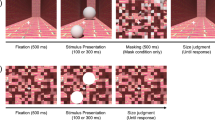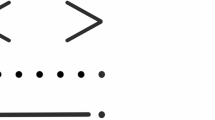Abstract
Visuo-spatial magnitude judgements are abstract in that they are detached from the specific sensory parameters on which they are based. Nevertheless, the visual system is actively reconstructing and interpreting the outside world, which sometimes causes reproducible geometric illusions. Here, we investigated the visual length perception of rhesus macaques, an Old World monkey species, in a delayed match-to-sample task and compared the non-human primates’ performance to the length judgment of human participants under identical conditions. The quantitative analysis of the length discrimination shows that humans and macaques both show a distance and size effect in judging length and have almost identical length judgment characteristics as determined by the widths of the discrimination functions and the Weber fractions. Moreover, both monkeys and humans were subject to the geometric Müller-Lyer illusion caused by inward or outward pointing ‘arrows’ at the ends of a line, resulting in over- or underestimation of length, respectively. The strength of the illusion effects (i.e., the magnitude of length misjudgement for stimuli with inward and outward pointing arrows at the end of the lines) was in the range between 1.17 and 1.57° of visual angle for both monkeys and the human participants, and thus very similar between the two primate species. Our results suggest that the visuo-spatial mechanisms underlying simple horizontal line-length perceptions in the human and macaque monkey are qualitatively and quantitatively similar, offering the possibility to investigate the neural correlates of geometric illusions in the monkey and to translate the findings to the human visual system.






Similar content being viewed by others
References
Barbet I, Fagot J (2002) Control of the corridor illusion in baboons (Papio papio) by gradient and linear-perspective depth cues. Perception 36:391–402
Bayne KAL, Davis RT (1983) Susceptibility of rhesus monkeys (Macaca mulatta) to the Ponzo illusion. Bull Psychom Soc 21:476–478
Benhar E, Samuel D (1982) Visual illusions in the baboon (Papio anubis). An Learn Behav 10:115–118
Castelli F, Glaser DE, Butterworth B (2006) Discrete and analogue quantity processing in the parietal lobe: a functional MRI study. Proc Natl Acad Sci USA 103:4693–4698
Dominguez KE (1954) A study of visual illusions in the monkey. J Genetic Psychol 85:105–127
Eagleman DM (2001) Visual illusions and neurobiology. Nat Rev Neurosci 2:920–926
Fias W, Lammertyn J, Reynvoet B, Dupont P, Orban GA (2003) Parietal representation of symbolic and nonsymbolic magnitude. J Cogn Neurosci 15:47–57
Fick A (1852) Erörterung eines physiologisch–optischen Phänomens. Zeitschrift für rationelle Medicin 2:83–94
Fujita K (1997) Perception of the Ponzo illusion by rhesus monkeys, chimpanzees, and humans: similarity and difference in the three primate species. Percept Psychophys 59:284–292
Hamburger K, Hansen T, Gegenfurtner KR (2007) Geometric-optical illusions at isoluminance. Vis Res 47:3276–3285
Hubbard EM, Piazza M, Pinel P, Dehaene S (2005) Interactions between number and space in parietal cortex. Nat Rev Neurosci 6:435–448
Kanizsa G (1979) Organization in vision. Praeger, New York
Müller-Lyer FC (1889/1981) “Optische Urtheilstäuschungen” Archiv für Anatomie und Physiologie, Physiologische Abteilung 2 (Supplement) 263–270, Translation by Day RH, Knuth H, 1981 “The contributions of F.C. Müller-Lyer” Perception, 10:126–14
Nakamura N, Fujita K, Ushitani T, Miyatat H (2006) Perception of the standard and the reversed Müller-Lyer figures in pigeons (Columba livia) and humans (Homo sapiens). J Comp Psychol 120:252–261
Nieder A (2002) Seeing more than meets the eye: processing of illusory contours in animals. J Comp Physiol A 188:249–260
Oppel JJ (1855) Über geometrisch–optische Täuschungen. Jahresbericht des physikalischen Vereins zu Frankfurt am Main, 37–47
Pepperberg IM, Vicinay J, Cavanagh P (2008) Processing of the Müller-Lyer illusion by a Grey parrot (Psittacus erithacus). Perception 37:765–781
Piazza M, Pinel P, Le Bihan D, Dehaene S (2007) A magnitude code common to numerosities and number symbols in human intraparietal cortex. Neuron 53:293–305
Pinel P, Piazza M, Le Bihan D, Dehaene S (2004) Distributed and overlapping cerebral representations of number, size, and luminance during comparative judgments. Neuron 41:983–993
Qiu J, Li H, Zhang Q, Liu Q, Zhang F (2008) The Muller-Lyer illusion seen by the brain: an event-related brain potentials study. Biol Psychol 77:150–158
Ro T, Rafal RD (1996) Perception of geometric illusions in hemispatial neglect. Neuropsychologia 34:973–978
Suganuma E, Pessoa VF, Monge-Fuentes V, Castro BM, Tavares MCH (2007) Perception of the Müller-Lyer illusion in capuchin monkeys (Cebus apella). Behav Brain Res 182:67–72
Tudusciuc O, Nieder A (2007) Neuronal population coding of continuous and discrete quantity in the primate posterior parietal cortex. Proc Natl Acad Sci USA 104:14513–14518
Tudusciuc O, Nieder A (2009) Contributions of primate prefrontal and posterior parietal cortices to length and numerosity representation. J Neurophysiol 101:2984–2994
Vallentin D, Nieder A (2008) Behavioral and prefrontal representation of spatial proportions in the monkey. Curr Biol 18:1420–1425
Weidner R, Fink GR (2007) The neural mechanisms underlying the Müller-Lyer illusion and its interaction with visuospatial judgments. Cereb Cortex 17:878–884
Acknowledgments
This work was supported by a research group grant (C11/SFB 550) from the German Research Foundation (DFG), and a grant from the VolkswagenStiftung to A.N.
Author information
Authors and Affiliations
Corresponding author
Rights and permissions
About this article
Cite this article
Tudusciuc, O., Nieder, A. Comparison of length judgments and the Müller-Lyer illusion in monkeys and humans. Exp Brain Res 207, 221–231 (2010). https://doi.org/10.1007/s00221-010-2452-7
Received:
Accepted:
Published:
Issue Date:
DOI: https://doi.org/10.1007/s00221-010-2452-7




